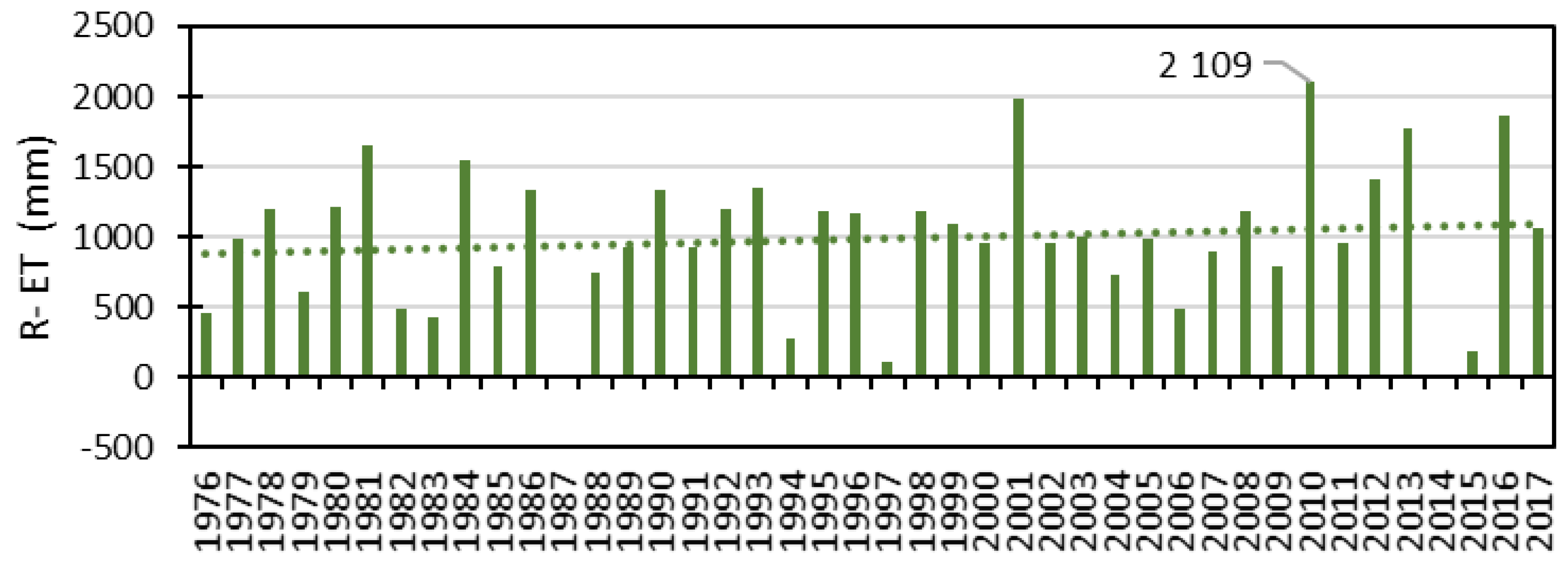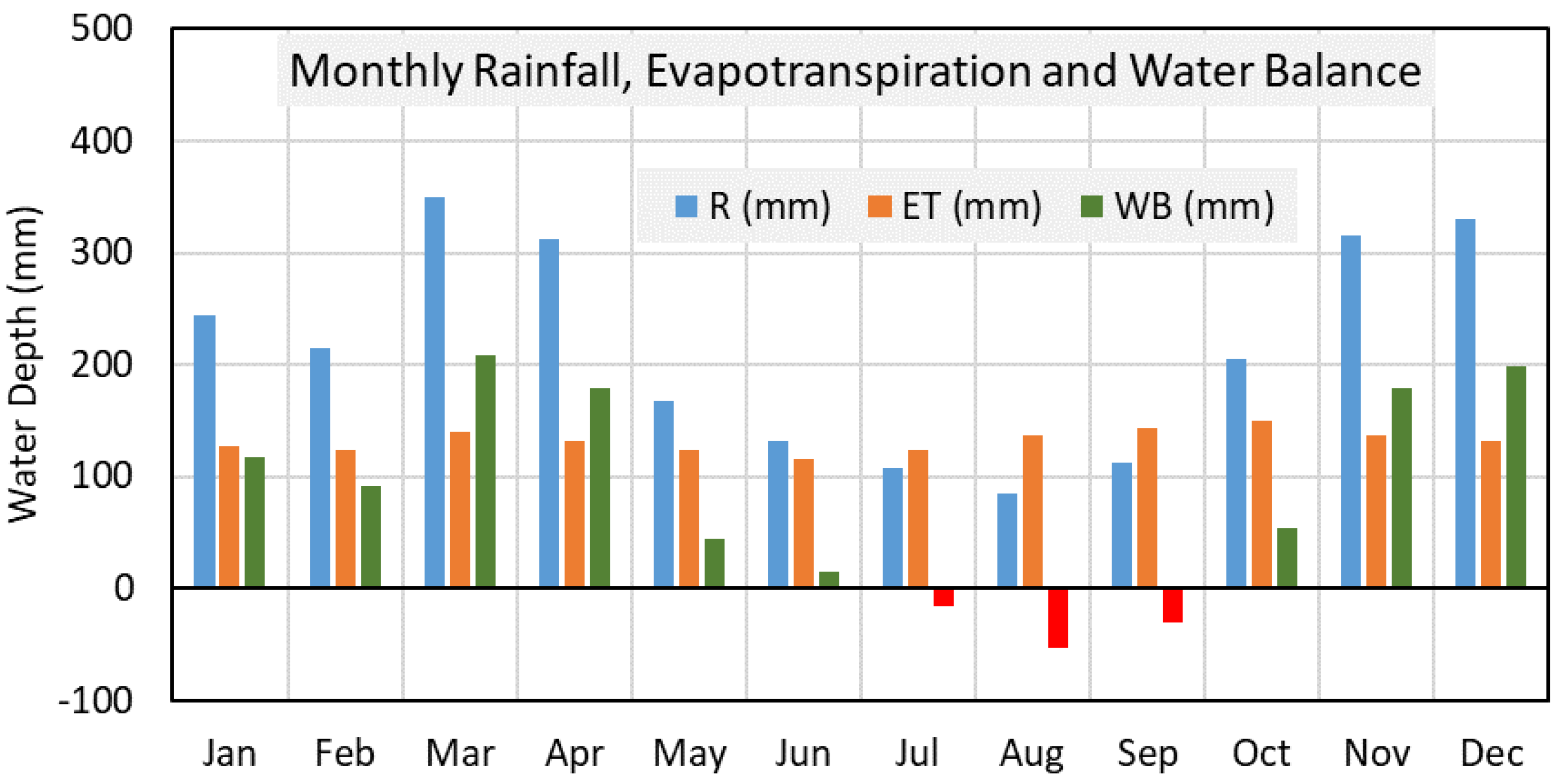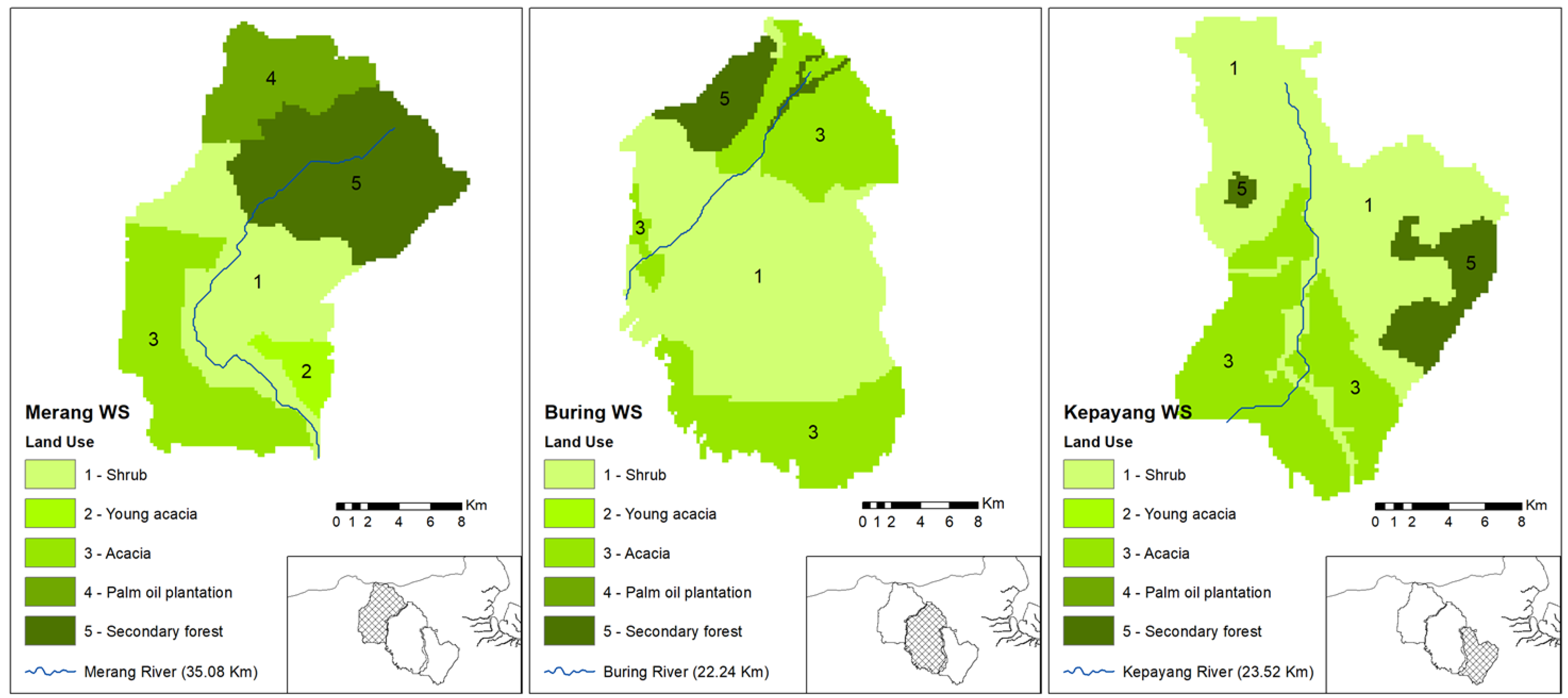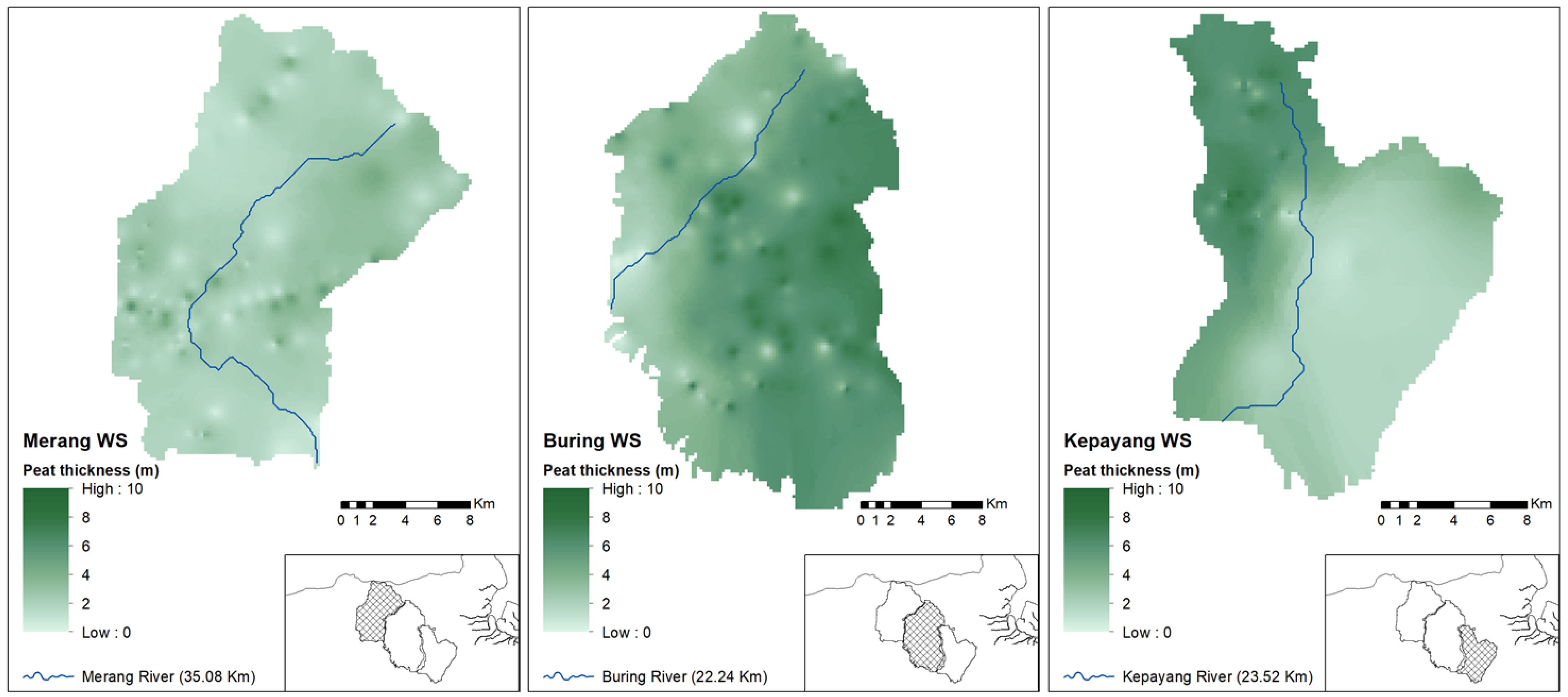Assessments of Underground Carbon Stocks in Merang-Kepahyang Peatlands, South Sumatra, Indonesia
Abstract
:1. Introduction
2. Materials and Methods
2.1. Study Site
- 1.
- Merang has an area of approximately 360.3 km2, and the river’s length is approximately 35 km;
- 2.
- Buring has an area of 458.5 km2 and the length of the main river is approximately 22 km;
- 3.
- Kepahyang has an area of approximately 275.3 km2, and the length of the main river is approximately 24 km.
2.2. Data Acquisition
2.2.1. Climate Data Acquisition
- 1.
- Minimum temperature (Tmn);
- 2.
- Maximum temperature (Tmx);
- 3.
- Averaged temperature (Tav);
- 4.
- Averaged air relative humidity (RH);
- 5.
- Rainfall (R);
- 6.
- Sunshine duration (SD);
- 7.
- Average wind velocity;
- 8.
- Main wind direction;
- 9.
- Maximum wind velocity.
2.2.2. Peat Data Acquisition
2.3. Peat Carbon Calculation
2.4. Land Use Map, Soil Map, and Elevation Map
- 1.
- Merang covers (40,425–40,432) m2 per grid with 8914 grids;
- 2.
- Buring covers (40,485–40,493) m2 per grid with 11,325 grids;
- 3.
- Kepahyang covers (40,619–40,626) m2 per grid with 6778 grids.
2.5. Peat Carbon Mapping
3. Results and Discussions
3.1. Temperature
3.2. Relative Humidity
3.3. Rainfall
3.4. Evapotrasnpiration
3.5. Climatic Water Balance
3.6. Monthly Water Balance
3.7. Wet and Dry Seasons
- 1.
- Wet1 starts from the first week of January to the third week of May with a percentage of occurrence of 98% over 42 years;
- 2.
- Dry1 starts from the second week of March to the first week of May with a percentage of occurrence of 98% over 42 years;
- 3.
- Wet2 starts from the first week of May to the fourth week of August with a percentage of occurrence of 95% over 42 years;
- 4.
- Dry2 starts from the first week of September to the second week of October, with a percentage of occurrence of 64% over 42 years;
- 5.
- Wet3 starts from the second week of October to the fourth week of December with a percentage of occurrence of 57% over 42 years;
- 6.
- Wet season starts from the second week of October to the fourth week of August, but it may occasionally be interrupted by the dry period between the third week of May to the fourth week of April;
- 7.
- Dry season starts from the first week of September to the second week of October.
3.8. Available Rainwater in the Wet and Dry Periods
3.9. Land Elevation Analysis
3.10. Land Uses Mapping
3.11. Soil Units Mapping
- 1.
- Physical properties, such as low bulk density () (<0.1 g cm−2), water saturation with high conductivity, subsidence, irreversible and flammable, so that plants will collapse easily.
- 2.
- Chemical properties, the soil is very acidic, the content of macro-phosphorus nutrients, potassium, and exchange-based and micronutrients, especially and , are very low.
3.12. Peat Properties Analysis
3.13. Peat Thickness Analysis
3.14. Carbon Stock Analysis
- 1.
- Based on water balance analysis, the highest rate of rainwater gain was 17.8 mm d−1 in Wet3, while that of the rainwater loss was −8.7 mm d−1 in Dry1. This is an indicator that the area has potential as peatland.
- 2.
- The peat depth map in this study was derived from 337 soil boring points from secondary data and an additional 69 soil boring points from field surveys. The boring points are scattered in ten soil units. This means that each soil unit has an average of 40.6 points.
- 3.
- This study estimated that the underground peat carbon was 220.2 Mt in Merang, 225.8 Mt in Buring, and 116.8 Mt in Kepahyang. Peat carbon density ranged from 0.98 to 14.65 kt ha−1 in Merang, from 0.68 to 14.3 kt ha−1 in Buring, and from 0.0 to 9.11 kt ha−1 in Kepahyang. The average peat carbon density was 6.11 kt ha−1 in Merang, 4.92 kt ha−1 in Buring, and 4.24 kt ha−1 in Kepahyang. This value is higher than that reported by Saragi-Sasmito et al. [1], 1752(401) C/, of which 93% was stored in belowground organic peat soils. Draper et al. [12] reported that peatland pole forest is found to be the most carbon-dense ecosystem identified in Amazonia ((1391 ± 710) C/) (note: 1 C = 1000 C).
- 4.
- The peat content estimation is higher than in the previous study. This could be caused by the approach to calculating the volume of the peat by the grid method. This is in line with the results from [4] which indicated that the geostatistical approach has as much as 10% more peat C than mean depth calculations.
- 5.
- Since land elevation is strongly correlated with peat thickness, the higher land elevation is also strongly correlated with higher peat carbon. Mostly in the higher land elevation, the peat is hemist-saprist. These are the mature peats that possess the highest belowground carbon stocks.
- 6.
- Secondary forest is concentrated at higher elevations, while shrub predominantly covers lower elevations. This happens because the water levels are dynamically below the land surface in the area with higher elevation. Therefore, the primary forests that were cleared by logging concessions years ago are naturally replaced by wild trees that formed the secondary forests. These aerobic-anaerobic conditions of the soils allowed the trees to grow correctly.
- 7.
- Shrubs predominantly cover the areas in the lower elevations where the water levels were usually closer to the surfaces, faced waterlogged problems, and formed floodplains. Due to these conditions, trees are challenging to grow.
- 8.
- The relationship between and is relatively linear, with , . This equation may be practically helpful for calculating , which is very difficult and time-consuming to measure.
4. Conclusions and Recommendations
Author Contributions
Funding
Institutional Review Board Statement
Informed Consent Statement
Data Availability Statement
Acknowledgments
Conflicts of Interest
References
- Saragi-Sasmito, M.F.; Murdiyarso, D.; June, T.; Sasmito, S.D. Carbon stocks, emissions, and aboveground productivity in restored secondary tropical peat swamp forests. Mitig. Adapt. Strateg. Glob. Chang. 2019, 24, 521–533. [Google Scholar] [CrossRef] [Green Version]
- Warren, M.W.; Kauffman, J.B.; Murdiyarso, D.; Anshari, G.; Hergoualc’h, K.; Kurnianto, S.; Purbopuspito, J.; Gusmayanti, E.; Afifudin, M.; Rahajoe, J.; et al. A cost-efficient method to assess carbon stocks in tropical peat soil. Biogeosciences 2012, 9, 4477–4485. [Google Scholar] [CrossRef] [Green Version]
- Warren, M.; Hergoualc’h, K.; Kauffman, J.B.; Murdiyarso, D.; Kolka, R. An appraisal of Indonesia’s immense peat carbon stock using national peatland maps: Uncertainties and potential losses from conversion. Carbon Balance Manag. 2017, 12, 12. [Google Scholar] [CrossRef] [PubMed]
- Beilman, D.W.; Vitt, D.H.; Bhatti, J.S.; Forest, S. Peat carbon stocks in the southern Mackenzie River Basin: Uncertainties revealed in a high-resolution case study. Glob. Chang. Biol. 2008, 14, 1221–1232. [Google Scholar] [CrossRef]
- Subardja, D.S.; Ritung, M.A.; Sukarman, E.S.; Subandiono, R.E. Petunjuk Teknis Klasifikasi Tanah Nasional. Edisi Ke-2. Balai Besar Penelitian dan Pengembangan Sumberdaya Lahan Pertanian; Badan Penelitian dan Pengembangan Pertanian: Bogor, Indonesia, 2016; p. 60. [Google Scholar]
- Agus, F.; Hairiah, K.; Mulyani, A.; World Agroforestry Centre (ICRAF). Pengukuran cadangan karbon tanah gambut; World Agroforestry Centre (ICRAF): Bogor, Indonesia, 2011. [Google Scholar]
- Sencaki, D.B.; Muhammad, D.J.; Sumargana, L.; Gandharum, L. Peatland Delineation Using Remote Sensing Data in Sumatera Island. In Proceedings of the 2018 IEEE Asia-Pacific Conference on Geoscience, Electronics and Remote Sensing Technology (AGERS), Jakarta, Indonesia, 18–19 September 2018; pp. 1–6, ZSCC: 0000004. [Google Scholar] [CrossRef]
- Carless, D.; Luscombe, D.J.; Gatis, N.; Anderson, K.; Brazier, R.E. Mapping landscape-scale peatland degradation using airborne lidar and multispectral data. Landsc. Ecol. 2019, 34, 1329–1345. [Google Scholar] [CrossRef] [Green Version]
- Carless, D.; Kulessa, B.; Booth, A.D.; Drocourt, Y.; Sinnadurai, P.; Street-Perrott, F.A.; Jansson, P. An integrated geophysical and GIS based approach improves estimation of peatland carbon stocks. Geoderma 2021, 402, 115176. [Google Scholar] [CrossRef]
- Zhang, Z.; Moore, J.C. Chapter 5—Basic Probability and Statistics. In Mathematical and Physical Fundamentals of Climate Change; Zhang, Z., Moore, J.C., Eds.; Elsevier: Boston, MA, USA, 2015; pp. 125–160. [Google Scholar] [CrossRef]
- Irsyad, F.; Saptomo, S.K.; Setiawan, B.I. Penentuan Awal Dan Durasi Musim Kemarau Menggunakan Fungsi Polynomial Dengan Aplikasi Visual Basic for Applications (VBA). Agromet 2018, 28, 40–46. [Google Scholar] [CrossRef]
- Draper, F.C.; Roucoux, K.H.; Lawson, I.T.; Mitchard, E.T.A.; Coronado, E.N.H.; Lähteenoja, O.; Montenegro, L.T.; Sandoval, E.V.; Zaráte, R.; Baker, T.R. The distribution and amount of carbon in the largest peatland complex in Amazonia. Environ. Res. Lett. 2014, 9, 124017, ZSCC: 0000160. [Google Scholar] [CrossRef]









| No | Parameter | Abbreviation |
|---|---|---|
| 1 | Porosity | POR |
| 2 | Bulk Density | BD |
| 3 | Particle Density | PD |
| 4 | Ash Content | AC |
| 5 | Organic Matter | OM |
| 6 | C-Organics | CO |
| 7 | pH | pH |
| 8 | Fiber Content | FC |
| Periods | Prob. | Water Depth (mm) | Peak Rate (mm) | ||||
|---|---|---|---|---|---|---|---|
| Min | Ave | Max | Min | Ave | Max | ||
| Wet1 | 98% | 250.1 | 556.3 | 862.5 | 4.8 | 10.1 | 15.4 |
| Dry1 | 98% | −219.1 | −103.6 | 12.0 | −8.7 | −4.6 | −0.5 |
| Wet2 | 95% | 311.0 | 619.8 | 928.5 | 4.2 | 8.5 | 12.8 |
| Dry2 | 64% | −397.1 | −209.7 | −22.4 | −5.1 | −3.0 | −0.9 |
| Wet3 | 57% | 203.3 | 470.5 | 738.8 | 3.5 | 10.7 | 17.8 |
| Dry3 | 12% | −67.6 | −34.2 | −0.8 | −7.1 | −4.4 | −1.7 |
| Parameter | Min | Max | Average | Std | Std (%) |
|---|---|---|---|---|---|
| POR (%) | 6 | 57 | 40 | 13 | 34 |
| BD (g/cc) | 0.08 | 0.26 | 0.14 | 0.05 | 35 |
| PD (g/cc) | 0.18 | 0.28 | 0.23 | 0.09 | 12 |
| AC (%) | 1 | 9 | 3 | 2 | 57 |
| OM (%) | 91 | 99 | 97 | 2 | 2 |
| CO (%) | 47 | 52 | 50 | 1 | 2 |
| FC (%) | 11 | 58 | 32 | 12 | 37 |
| pH | 4.5 | 6.2 | 5.4 | 0.5 | 10 |
Publisher’s Note: MDPI stays neutral with regard to jurisdictional claims in published maps and institutional affiliations. |
© 2022 by the authors. Licensee MDPI, Basel, Switzerland. This article is an open access article distributed under the terms and conditions of the Creative Commons Attribution (CC BY) license (https://creativecommons.org/licenses/by/4.0/).
Share and Cite
Suharnoto, Y.; Setiawan, B.I.; Pribadi, A.; Muslihat, L.; Buchori, D. Assessments of Underground Carbon Stocks in Merang-Kepahyang Peatlands, South Sumatra, Indonesia. Sustainability 2022, 14, 5473. https://doi.org/10.3390/su14095473
Suharnoto Y, Setiawan BI, Pribadi A, Muslihat L, Buchori D. Assessments of Underground Carbon Stocks in Merang-Kepahyang Peatlands, South Sumatra, Indonesia. Sustainability. 2022; 14(9):5473. https://doi.org/10.3390/su14095473
Chicago/Turabian StyleSuharnoto, Yuli, Budi Indra Setiawan, Andik Pribadi, Lili Muslihat, and Damayanti Buchori. 2022. "Assessments of Underground Carbon Stocks in Merang-Kepahyang Peatlands, South Sumatra, Indonesia" Sustainability 14, no. 9: 5473. https://doi.org/10.3390/su14095473
APA StyleSuharnoto, Y., Setiawan, B. I., Pribadi, A., Muslihat, L., & Buchori, D. (2022). Assessments of Underground Carbon Stocks in Merang-Kepahyang Peatlands, South Sumatra, Indonesia. Sustainability, 14(9), 5473. https://doi.org/10.3390/su14095473






